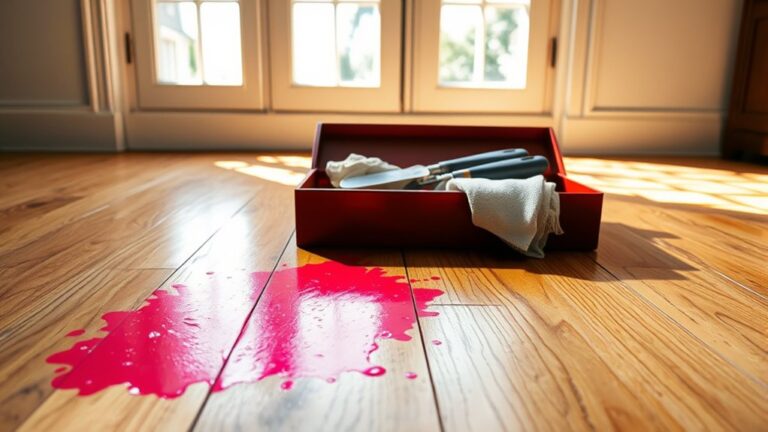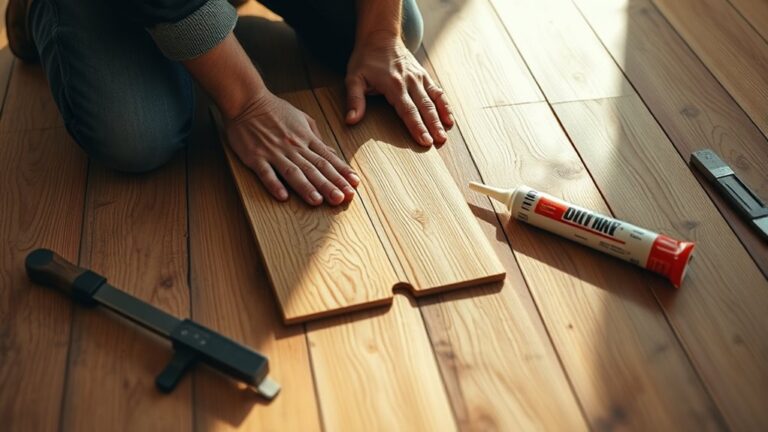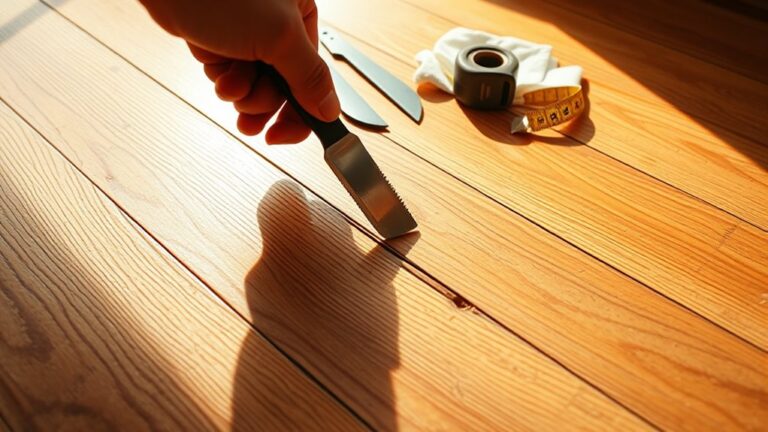To get urine out of hardwood floors, start by blotting the spill immediately with a clean cloth to soak up liquid without spreading it. Use a gentle mix of white vinegar and water to break down urine, then wipe with a damp cloth to remove residue. Dry the area thoroughly to avoid damage. Choose enzyme-based cleaners for stubborn stains, but avoid harsh chemicals. Prompt cleanup prevents odors and stains. There are more tips on protecting and restoring your floors effectively.
Identifying Urine Stains on Hardwood Floors
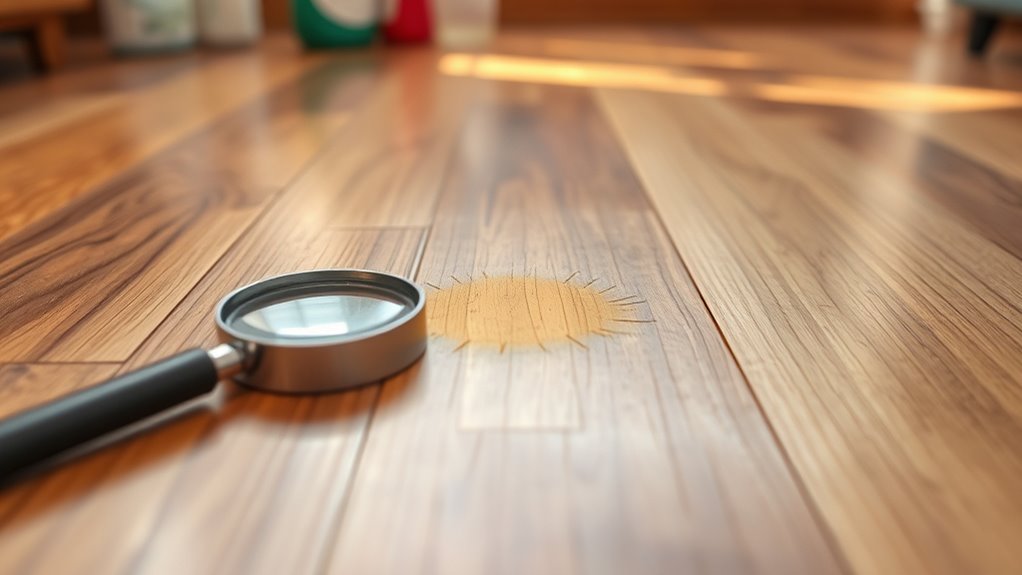
Urine stains on hardwood floors often appear as discolored spots or areas where the finish has dulled or bubbled. For effective urine detection, start by closely inspecting the floor for any irregularities in color or texture. Stain recognition is essential; look for yellowish or darkened patches that may indicate urine absorption. You can use a blacklight in a dark room to enhance detection—urine stains will fluoresce under UV light, making identification easier. Trust your senses too; a faint ammonia-like odor often accompanies fresh stains. Being methodical in your inspection guarantees you identify all affected areas before treatment, helping you preserve your floor’s integrity. Mastering urine detection and stain recognition empowers you to act confidently and restore your hardwood floors effectively.
Immediate Steps to Take After an Accident
Although accidents can be frustrating, acting quickly is vital to prevent long-term damage to your hardwood floors. Your accident response should start with blotting the urine using paper towels or a clean cloth—avoid rubbing, as it can spread the stain. After absorbing as much liquid as possible, use a damp cloth to gently wipe the area, diluting the urine without saturating the wood. Prompt action helps minimize odor and staining. Next, dry the spot thoroughly using a fan or open windows to promote air circulation. This step is essential to avoid moisture seeping into the wood, which can cause warping. By following these immediate steps with care, you’ll protect both the appearance and integrity of your hardwood floors, maintaining your home’s freedom from lasting damage.
Choosing the Right Cleaning Products
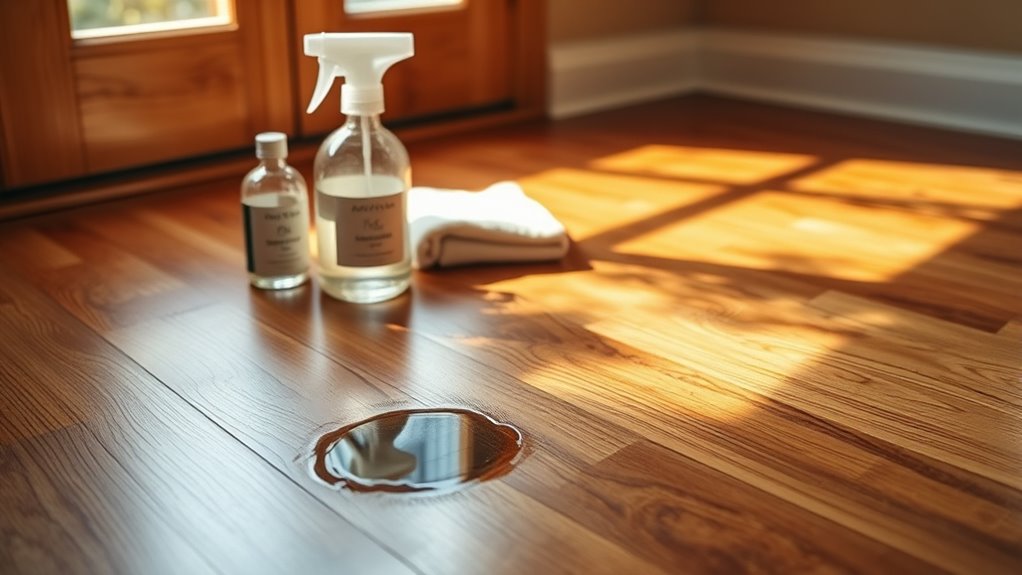
You’ll want to pick cleaning products with safe ingredients that won’t damage your hardwood floors. Enzyme-based cleaners are ideal because they break down urine molecules effectively. Avoid harsh chemicals like bleach or ammonia, as these can harm the wood and finish.
Safe Cleaning Ingredients
Since hardwood floors are sensitive to harsh chemicals, it’s important to choose cleaning products that effectively remove stains without damaging the wood or its finish. You want ingredients that are both gentle and efficient. Consider these safe cleaning options:
- Vinegar solution – Dilute white vinegar with water to break down urine stains and neutralize odors without harming the floor.
- Baking soda – Sprinkle on the affected area to absorb moisture and deodorize naturally before wiping away.
- Mild dish soap – Use a few drops mixed with water for gentle cleaning that won’t strip the wood’s finish.
- Warm water – Essential for rinsing off cleaning agents without leaving residue.
Using these ingredients lets you maintain your floors’ beauty while tackling urine stains safely and effectively.
Enzyme-Based Cleaners
While gentle household ingredients can handle minor urine stains, tougher or older spots may need more specialized care. Enzyme-based cleaners offer a powerful solution by breaking down urine molecules at their source, ensuring thorough removal and preventing lingering odors. When selecting these products, look for proven enzyme effectiveness tailored for hardwood surfaces. Applying the cleaner according to the instructions maximizes its ability to penetrate and neutralize stains. This method not only cleans but also helps maintain your floor’s integrity. Using enzyme-based cleaners as part of your cleaning methods provides a natural, efficient way to tackle stubborn urine stains, giving you the freedom to restore your hardwood floors without worry. Always test a small area first to confirm compatibility with your floor finish.
Vermijd agressieve chemicaliën
Although it might be tempting to reach for strong cleaning agents, harsh chemicals can damage your hardwood floors and worsen urine stains. To protect your vloeren and enjoy lasting results, steer clear of chemical risks by opting for natural alternatives. Here’s how you can choose wisely:
- Pick enzyme-based or plant-derived cleaners that break down urine without harming wood.
- Avoid bleach, ammonia, or acidic cleaners which strip finish and discolor wood.
- Test any cleaner on a small, hidden area first to guarantee no damage.
- Use gentle tools like soft cloths or sponges to apply cleaners, preserving the floor’s surface.
Effective Cleaning Techniques for Urine Removal
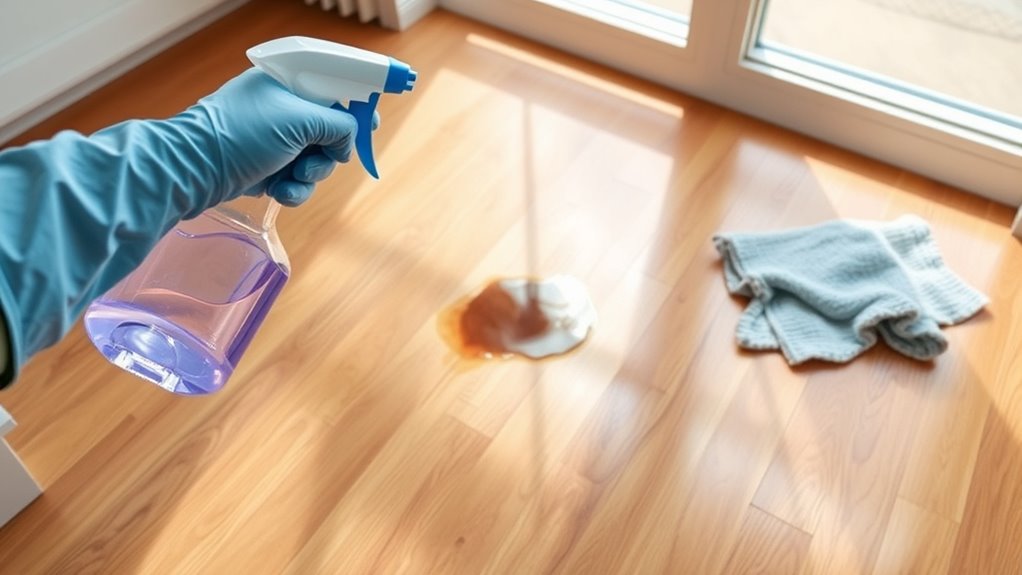
When dealing with urine on hardwood floors, prompt and thorough cleaning is essential to prevent stains and odors. Start by blotting the urine with a clean cloth to soak up as much as possible. Use natural remedies like a mixture of white vinegar and water, which gently breaks down urine without harsh chemicals. Equip yourself with effective cleaning tools: microfiber cloths for blotting, soft brushes for scrubbing, and spray bottles for even application. After cleaning, dry the area thoroughly to avoid moisture damage.
| Stap | Recommended Tool | Natural Remedy |
|---|---|---|
| Blot urine | Microfiber cloth | None |
| Apply cleaner | Spray bottle | Vinegar-water solution |
| Scrub | Soft brush | Baking soda (optional) |
| Afspoelen | Vochtige doek | Water |
| Dry | Dry towel or fan | None |
Preventing Odors and Discoloration
To prevent odors and discoloration, you need to clean up urine immediately before it soaks into the wood. Waiting allows bacteria and stains to set, making removal much harder. Applying a protective sealant afterward can create a barrier that helps keep your floors safe from future accidents.
Immediate Cleanup Importance
Because urine can quickly seep into hardwood pores, cleaning it up immediately is crucial to prevent lingering odors and discoloration. Taking prompt response and quick action means you’ll avoid deep stains and stubborn smells. Here’s what you should do right away:
- Blot the urine with a clean, absorbent cloth to soak up as much liquid as possible.
- Use a mild cleaner or a vinegar-water solution to neutralize the area.
- Dry the spot thoroughly with a fan or open windows to speed evaporation.
- Repeat the process if necessary to guarantee no residue remains.
Acting fast frees you from long-term damage and keeps your hardwood floor looking fresh and odor-free. Don’t delay—your floor’s integrity depends on it.
Protective Sealant Application
Applying a protective sealant is one of the most effective ways to prevent urine odors and discoloration from reoccurring on your hardwood floors. You’ll want to choose the right sealant type—water-based polyurethane offers durability and quick drying, while oil-based sealants provide a richer finish but take longer to cure. Before applying, make certain the floor is clean and completely dry. Use proper application techniques: apply thin, even coats with a high-quality brush or roller, following the wood grain to avoid streaks. Allow adequate drying time between coats, usually 2-4 hours. Two to three coats are typically sufficient for strong protection. By sealing your floors properly, you create a barrier that resists moisture and odors, giving you freedom from recurring stains and keeping your hardwood looking fresh longer.
When to Call a Professional Cleaner
Although you can often remove urine stains on your own, certain situations call for professional help. When you encounter stubborn odors, deep stains, or extensive damage, it’s wise to evaluate professional services. Cleaning specialists have the tools and expertise to restore your hardwood floors effectively. Call a professional cleaner if:
- Urine has soaked through multiple layers of the hardwood.
- DIY methods fail to eliminate strong odors.
- The stain covers a large area, making self-cleaning impractical.
- You notice warping, discoloration, or structural damage.


